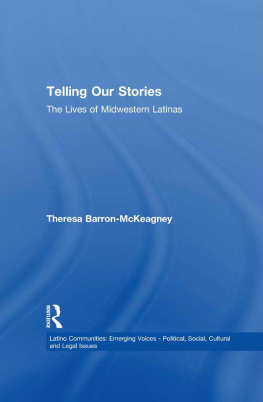from COVERALLS to ZOOT SUITS
2013 Elizabeth R. Escobedo
All rights reserved. Manufactured in the United States of America
Designed by Michelle Coppedge and set in Minion by code Mantra
The paper in this book meets the guidelines for permanence and durability of the Committee on Production Guidelines for Book Longevity of the Council on Library Resources.
The University of North Carolina Press has been a member of the Green Press Initiative since 2003.
Library of Congress Cataloging-in-Publication Data
Escobedo, Elizabeth Rachel.
From coveralls to zoot suits : the lives of Mexican American women on the World War II home front / Elizabeth R. Escobedo.
p. cm.
Includes bibliographical references and index.
ISBN 978-1-4696-0205-9 (cloth : alk. paper)
1. Mexican American womenCaliforniaLos AngelesSocial conditions20th century. 2. Mexican American women EmploymentCaliforniaLos AngelesHistory. 3. World War, 19391945WomenCaliforniaLos Angeles. 4. World War, 19391945War workCaliforniaLos Angeles. 5. World War, 19391945Social aspectsCaliforniaLos Angeles. I. Title.
F869.L89M5156 2013
305.896872073079494dc23
2012028591
17 16 15 14 13 5 4 3 2 1
Portions of this work appeared previously in somewhat different form in Elizabeth R. Escobedo, The Pachuca Panic: Sexual and Cultural Battlegrounds in World War II Los Angeles, Western Historical Quarterly 38, no. 2 (Summer 2007): 13356. Western History Association.
Reprinted by permission.
forAUNTIE ERNIEandAUNTIE IDA ,
and all the other women who lived it
CONTENTS
Acknowledgments
Abbreviations
Introduction
1 The Pachuca Panic
2 Americanos Todos
Mexican Women and the Wartime State and Media
3 Reenvisioning Rosie
Mexican Women and Wartime Defense Work
4 Respectable Rebellions
Mexican Women and the World of Wartime Leisure
5 Civil Rights and Postwar Life
Epilogue
Notes
Bibliography
Index
ILLUSTRATIONS
A Mexican American woman in a zoot suit, 1944
A Mexican American youth in a zoot suit, 1944
Dora Barrios, Frances Silva, and Lorena Encinas arrested during the Sleepy Lagoon investigation, 1942
Young women under investigation for connection with the Sleepy Lagoon case
Young Mexican American women in Los Angeles, 1943
Mexican American and African American youths jitterbugging, 1943
A Mexican American woman poses in her zoot suit while waiting for the Red Car in Los Angeles, 1945
Office of War Information poster
Douglas Aircraft billboard aimed at recruiting Mexican workers, circa 194244
Front page of the Douglas Airview News featuring assembler Juanita Escareno, October 1944
Photograph of young Mexican American women in the Eastside Journal, June 1943
Douglas Aircraft employee Theresa Hernandez, October 1943
Celia Dominguez, a wing driller for the B -17 at Douglas Aircraft, July 1943
Mexican, black, and white women working on a cockpit enclosure at Douglas Aircraft, 1945
Black, Mexican, and white women sewing together at the Pacific Parachute Company in San Diego, 1942
Members of the Seoritas USO , 1943
A Mexican American clerical worker, circa 1955
ACKNOWLEDGMENTS
I could not have written this book without the support of many generous individuals and institutions. Although it is difficult to find words adequate enough to express the gratitude I feel toward the friends, colleagues, and loved ones who helped me along the way, it gives me great pleasure to acknowledge them here.
I started this book during my graduate career at the University of Washington, where I had the good fortune to work with an incredibly talented and supportive group of teachers and scholars. I learned much from Suzanne Lebsocks thoughtful observations and dedication to uncovering the lives of ordinary women. Jim Gregory offered me encouragement and sage advice throughout this project and my career in general, and his astute reading of my work pushed me to make important connections and to broaden the scope of my study. I am deeply grateful to him. Susan Glenn served as an ideal mentor and adviser at every turn. She gave generously of her time to read and reread numerous drafts of this study in its earlier stages, always providing excellent suggestions and valuable criticisms. Her unflagging faith that I had the ability to tell this story sustained me over the years, and I consider myself among the most fortunate to continue to benefit from her wisdom and support.
Generous financial support also saw me through the research and writing process. I am thankful to the University of Washingtons History Department, the Historical Society of Southern California, the Coalition for Western Womens History, the Woodrow Wilson National Fellowship Foundation, and the Haynes Foundation for providing me with funding. I am especially grateful to have received a Ford Foundation Post-Doctoral Fellowship in 20078, an honor that allowed me to take time away from my teaching responsibilities in order to focus on significant revisions to the manuscript.
While conducting research, numerous librarians and archivists kindly gave of their time to help me with my research. I would like to thank the staffs of the California State Archives, the Huntington Library, Stanfords Department of Special Collections and University Archives, the National Archives and Records Administration at San Bruno and College Park, and the Southern California Library for helping me to locate key documents and making my research trips fruitful and comfortable. In particular, Jeff Rankin always greeted me with a friendly smile and witty story, making my work at UCLAs Special Collections especially enjoyable. At Boeing, Patricia McGinnis directed me to key sources; volunteer Jim Turner scanned materials for me; and Mary Kane assisted me in making sure that I could include key photos in the manuscript. I am also grateful to Wendy Aron, Willie Burton, Terry Truong, and Judge Terry Friedman of the Juvenile Division of the L.A. County Superior Court for helping me to navigate the petition process and ultimately granting me permission to look at 1940s L.A. County Juvenile Court case files. With much encouragement, Sherna Gluck also allowed me to quote from several volumes of the Rosie the Riveter Revisited Oral History Project, an indispensable resource at California State University, Long Beach. Robert Marshall of the CSU Northridge Urban Archives deserves special mention as well. From day one, Marshall expressed tremendous enthusiasm for my project, and our conversations about history provided me with many important insights.
For seeing this book to completion, I also thank the incredibly talented editorial and production staff at UNC Press. I am very grateful to Chuck Grench for his interest in this project and for serving as a model of professionalism and guidance throughout the entire process. I am thankful, too, for the care and attentiveness Mary Caviness provided in her edits of the manuscript, and to the efforts of Sara Jo Cohen, who always lent a helping hand.
One of the greatest joys of being a historian has been surrounding myself with an incredibly talented circle of friends and colleagues who have shared their knowledge, nurtured my research, and offered a friendly ear and a shoulder to lean on. I am especially thankful for Shana Bernstein, Marisela Chvez, Lisa Flores, Gabriela Gonzlez, Monica Perales, Gina Marie Pitti, and Mary Ann Villarreal, all of whom provided me with me an invaluable network of friendship and unflagging support across the nation. In graduate school and beyond, fellow University of Washington alums Nelly Blacker-Hanson, Susan Bragg, Jeff Brune, Matt Klingle, Jen Seltz, Matt Sneddon, and Seema Sohi also offered sage advice and encouragement that Ive come to rely on. I will always be especially grateful to Susan Bragg for reading numerous pages of the manuscript and for offering astute, incisive feedback at critical points in my writing process.
Next page




